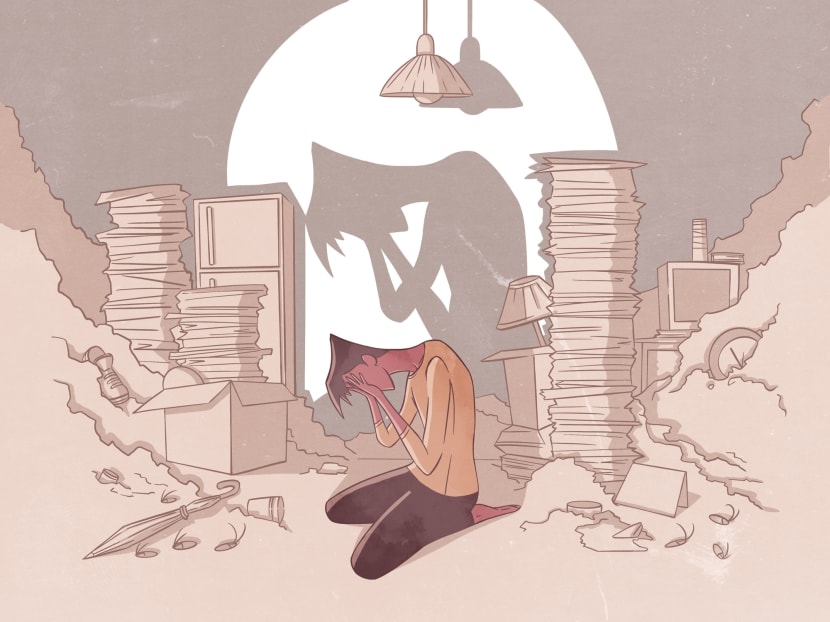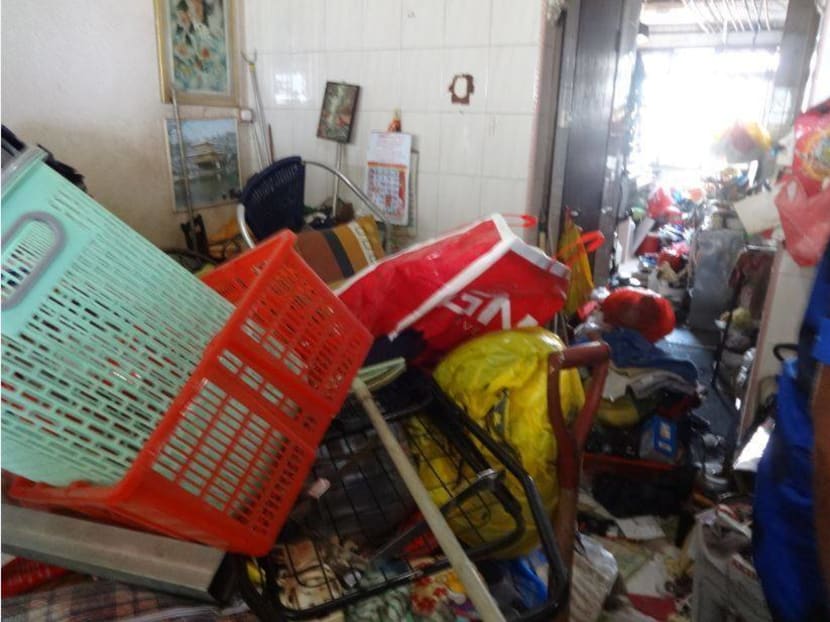Hoarders need emotional support. Here's how we can help them
The tragic case of a 68-year-old man who was found dead among piles of rubbish in his flat recently has once again cast a spotlight on a familiar but often tricky-to-solve problem: Hoarding.

Persuading hoarders to go for therapy is one solution — even though this may not be easy since hoarders often do not believe that they have a problem.
The tragic case of a 68-year-old man who was found dead among piles of rubbish in his flat recently has once again cast a spotlight on a familiar but often tricky-to-solve problem: Hoarding.
An Institute of Mental Health study in 2010 found that one in 50 people will display hoarding behaviour in their lifetime.
According to psychologists, hoarding becomes a behavioural disorder when a person has great difficulty in discarding objects with seemingly little value, such as stacks of yellowed newspapers and plastic bags full of old clothes.
The ever-growing pile of the mainly useless items subsequently leads to a cluttered home, giving rise to safety concerns since clutter may create fire and tripping hazards.
The excessive clutter could also become a source of great distress and frustration for the hoarder’s family members, leading to strained relations or even rejection of the hoarder, studies have shown.
So, how does someone end up as a hoarder?
I have conducted lengthy interviews with seven senior citizens in Singapore, five of them hoarders.
My study supports findings of past research showing that hoarding, and its degree of severity, is directly linked to emotional insecurity which arises from social isolation and a lack of resources, be they financial, material and emotional.
The seniors interviewed, aged between 57 and 78 years old, are residents of one- to five-room Housing and Development Board flats.
Four of the hoarders live in one-room rental flats and receive financial aid under the Public Assistance scheme. The fifth hoarder lives in a three-room flat that she owns and is dependent on her working adult son and church subsidies for her husband.
The two non-hoarders are both retired military personnel currently re-employed as non-uniformed support staff in the Singapore Armed Forces. They live in four- and five-room flats.
During my visits to their homes, I found that the types of hoarding items included toys, antique furniture, idols, clothing, plastic utensils, electrical appliances and trolleys.
These items could be categorised as low or no value (plastic bottles, toilet paper, washing powder); gifts and discarded items by others (umbrellas given out at senior citizens’ events and old electrical appliances) and those with sentimental value (kitchen utensils or an antique table left by a deceased mother).
My interviews with the senior hoarders revealed a common thread in their life stories — all five of them came from poor and humble backgrounds and have led tough lives.
In contrast, the two non-hoarders are simple and self-assured individuals who do most of the household cleaning in their homes themselves. The two men do not buy more things than necessary even when the items are on sale.
Since the five senior hoarders have few friends and face some form of social isolation, they hoard to deal with their emotional insecurity. The lack of physical space in their one-room flats amplified the hoarding effect, and they seem to have adapted to the reduced living space with the increased hoarding.
Major life events, such as losing their parents or suffering an illness, further accelerated the hoarding process for some of them.

For hoarders to fully heal, the support of those around them — including the larger community — is crucial, says the author. Photo: Municipal Services Office
Ex-factory worker Madam Alice’s case was the worst among the five. Her most prized hoarding items were stuffed toys still wrapped in plastic bags.
The 68-year-old single woman told me: “You know we were very poor when we were young, my mother could not afford to buy stuffed toys. When I collect these stuffed toys, I feel very happy.”
For Mdm Alice, who suffers from depression and anxiety disorders, these stuffed toys packed near her bed give her a sense of security and comfort.
An element of cognitive indecisiveness — where the person either avoids making decisions or changes his/her views constantly, and which psychologists have identified as playing a crucial role in hoarding behaviour — could also be detected in the five senior citizens.
Mdm Lim, 63, the one with a son, keeps used plastic soft drink bottles and souvenirs, while Mdm Alice continues to keep plastic bags of medication from various visits to the doctor.
Although the two women started hoarding with the intention to use the items in the future, as the hoarding increased over time, they could not bear to discard the excess collection.
So what can society do to help hoarders?
Persuading them to go for therapy is one solution — even though this may not be easy since hoarders often do not believe that they have a problem, and are unlikely to voluntarily seek help. Thus, the immediate family members of a hoarder can play a crucial role in getting the person to go for therapy.
Treatments for hoarding disorders include psychoeducation, where the hoarders and their guardians or caregivers are provided with information on hoarding, and learn various ways to sort and discard the items they have collected, among other things.
And for hoarders to fully heal, the support of those around them — including the larger community — is crucial.
This is why the Government set up a Hoarding Taskforce in 2014 comprising numerous agencies that handle housing, grassroots organisations, the environment, law enforcement, fire safety and mental health.
My field study also shows that Singapore does have strong networks of volunteers, welfare and religious organisations looking after the interest of seniors, especially those who live alone and are in the lower-income group.
For example, Mdm Alice’s state of mental health makes her unable to clean her house, since the extreme clutter makes cleaning difficult. Thankfully, there are volunteers who help her to clear her hoarding, and visit her weekly to clean up her flat.
There are also anecdotal stories of hoarders who gradually stop their unhealthy habits as they find comfort in redirecting their attention and energy on hobbies, spending time with people/pets or volunteering. This is one area which multidisciplinary group of professionals or volunteers in the community could explore seriously.
As Singapore increases our focus on building a caring and inclusive society, awareness and solutions on hoarding disorders should be an area to pay attention to just like depression or other illnesses. Community care agencies could raise awareness of the problem as a form of upstream prevention.
The community should be encouraged to “care enough” to tap the multi-agency Hoarding Taskforce to help provide psychological care and assistance to declutter before it becomes a fire or physical hazard — if they notice a relative or neighbour who demonstrates hoarding symptoms.
At the grassroot level, hoarders seeking treatment and their caregivers as well as volunteers could form a network of care to help and support each other.
Just as it takes a village to raise a child, it will take the community to help pull such aged, often lonely, hoarders away from the brink of tragedy.
ABOUT THE AUTHOR:
Sng Hock Lin is pursuing a PhD in Gerontology at the Singapore University of Social Sciences.






